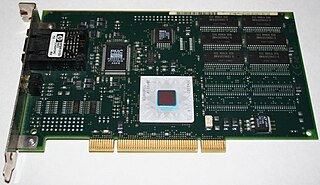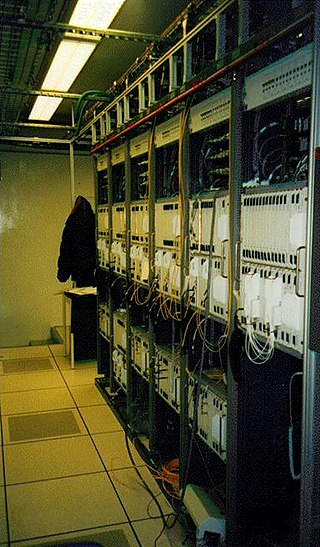
Asynchronous Transfer Mode (ATM) is a telecommunications standard defined by the American National Standards Institute and ITU-T for digital transmission of multiple types of traffic. ATM was developed to meet the needs of the Broadband Integrated Services Digital Network as defined in the late 1980s, and designed to integrate telecommunication networks. It can handle both traditional high-throughput data traffic and real-time, low-latency content such as telephony (voice) and video. ATM provides functionality that uses features of circuit switching and packet switching networks by using asynchronous time-division multiplexing.
Multiprotocol Label Switching (MPLS) is a routing technique in telecommunications networks that directs data from one node to the next based on labels rather than network addresses. Whereas network addresses identify endpoints the labels identify established paths between endpoints. MPLS can encapsulate packets of various network protocols, hence the multiprotocol component of the name. MPLS supports a range of access technologies, including T1/E1, ATM, Frame Relay, and DSL.
Quality of service (QoS) is the description or measurement of the overall performance of a service, such as a telephony or computer network, or a cloud computing service, particularly the performance seen by the users of the network. To quantitatively measure quality of service, several related aspects of the network service are often considered, such as packet loss, bit rate, throughput, transmission delay, availability, jitter, etc.

Synchronous Optical Networking (SONET) and Synchronous Digital Hierarchy (SDH) are standardized protocols that transfer multiple digital bit streams synchronously over optical fiber using lasers or highly coherent light from light-emitting diodes (LEDs). At low transmission rates data can also be transferred via an electrical interface. The method was developed to replace the plesiochronous digital hierarchy (PDH) system for transporting large amounts of telephone calls and data traffic over the same fiber without the problems of synchronization.

Time-division multiplexing (TDM) is a method of transmitting and receiving independent signals over a common signal path by means of synchronized switches at each end of the transmission line so that each signal appears on the line only a fraction of time in an alternating pattern. It can be used when the bit rate of the transmission medium exceeds that of the signal to be transmitted. This form of signal multiplexing was developed in telecommunications for telegraphy systems in the late 19th century, but found its most common application in digital telephony in the second half of the 20th century.
The Point-to-Point Protocol over Ethernet (PPPoE) is a network protocol for encapsulating Point-to-Point Protocol (PPP) frames inside Ethernet frames. It appeared in 1999, in the context of the boom of DSL as the solution for tunneling packets over the DSL connection to the ISP's IP network, and from there to the rest of the Internet. A 2005 networking book noted that "Most DSL providers use PPPoE, which provides authentication, encryption, and compression." Typical use of PPPoE involves leveraging the PPP facilities for authenticating the user with a username and password, predominately via the PAP protocol and less often via CHAP. Around 2000, PPPoE was also starting to become a replacement method for talking to a modem connected to a computer or router over an Ethernet LAN displacing the older method, which had been USB. This use-case, connecting routers to modems over Ethernet is still extremely common today.
A leased line is a private telecommunications circuit between two or more locations provided according to a commercial contract. It is sometimes also known as a private circuit, and as a data line in the UK. Typically, leased lines are used by businesses to connect geographically distant offices.
The use of Asynchronous Transfer Mode (ATM) technology and services creates the need for an adaptation layer in order to support information transfer protocols, which are not based on ATM. This adaptation layer defines how to segment higher-layer packets into cells and the reassembly of these packets. Additionally, it defines how to handle various transmission aspects in the ATM layer.
In computer networking and telecommunications, a pseudowire is an emulation of a point-to-point connection over a packet-switched network (PSN).
In computer networking and telecommunications, TDM over IP (TDMoIP) is the emulation of time-division multiplexing (TDM) over a packet-switched network (PSN). TDM refers to a T1, E1, T3 or E3 signal, while the PSN is based either on IP or MPLS or on raw Ethernet. A related technology is circuit emulation, which enables transport of TDM traffic over cell-based (ATM) networks.

The ATM Forum was founded in 1991 to be the industry consortium to promote Asynchronous Transfer Mode technology used in telecommunication networks; the founding president and chairman was Fred Sammartino of Sun Microsystems. It was a non-profit international organization. The ATM Forum created over 200 implementation agreements.

A passive optical network (PON) is a fiber-optic telecommunications technology for delivering broadband network access to end-customers. Its architecture implements a point-to-multipoint topology in which a single optical fiber serves multiple endpoints by using unpowered (passive) fiber optic splitters to divide the fiber bandwidth among the endpoints. Passive optical networks are often referred to as the last mile between an Internet service provider (ISP) and its customers. Many fiber ISPs prefer this technology.
The next-generation network (NGN) is a body of key architectural changes in telecommunication core and access networks. The general idea behind the NGN is that one network transports all information and services by encapsulating these into IP packets, similar to those used on the Internet. NGNs are commonly built around the Internet Protocol, and therefore the term all IP is also sometimes used to describe the transformation of formerly telephone-centric networks toward NGN.

A metropolitan-area Ethernet, Ethernet MAN, or metro Ethernet network is a metropolitan area network (MAN) that is based on Ethernet standards. It is commonly used to connect subscribers to a larger service network or for internet access. Businesses can also use metropolitan-area Ethernet to connect their own offices to each other.
An edge device is a device that provides an entry point into enterprise or service provider core networks. Examples include routers, routing switches, integrated access devices (IADs), multiplexers, and a variety of metropolitan area network (MAN) and wide area network (WAN) access devices. Edge devices also provide connections into carrier and service provider networks. An edge device that connects a local area network to a high speed switch or backbone may be called an edge concentrator.
In 2001, the IETF set up the Pseudowire Emulation Edge to Edge working group, and this group was given the initialism PWE3. The working group was chartered to develop an architecture for service provider edge-to-edge pseudowires and service-specific documents detailing the encapsulation techniques.
Virtual leased lines (VLL), also referred to as virtual private wire service (VPWS) or EoMPLS, is a way to provide Ethernet-based point to point communication over Multiprotocol Label Switching (MPLS) or Internet Protocol networks. VLL uses the pseudo-wire encapsulation for transporting Ethernet traffic over an MPLS tunnel across an MPLS backbone. VLL also describes a point to point bonded connection using the broadband bonding technology.
Connection-oriented Ethernet refers to the transformation of Ethernet, a connectionless communication system by design, into a connection-oriented system. The aim of connection-oriented Ethernet is to create a networking technology that combines the flexibility and cost-efficiency of Ethernet with the reliability of connection-oriented protocols. Connection-oriented Ethernet is used in commercial carrier grade networks.
Carrier Ethernet is a marketing term for extensions to Ethernet for communications service providers that utilize Ethernet technology in their networks.

Axerra Networks is a leading provider of circuit emulation and service emulation solutions over packet access networks for mobile backhaul and business service delivery.






